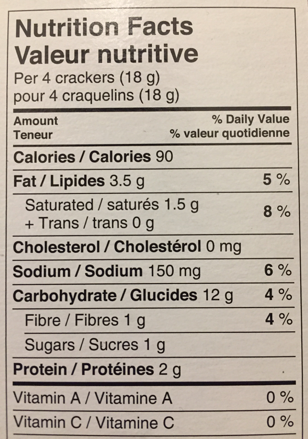
Cardiovascular disease is still the number one cause of death globally (1). Eating too much sodium is linked to high blood pressure which is a major risk factor for heart disease. Here are 5 questions to test your sodium IQ!
Watch Sue’s national TV interview on YouTube or click on the image below.

1. True or False: We need sodium to stay healthy.
True! We do need some sodium to maintain our blood pressure and fluid levels in our body. Sodium is also needed to keep our muscles and nerves running smoothly. The problem is that most of us are getting too much sodium, which can lead to health problems such as hypertension (high blood pressure) and cardiovascular disease.
On average, we should stick to less than 2,300 mg of sodium a day, but we’re eating about 1½ times that amount (2). In fact, 3 out of 5 Canadians eat too much sodium (2). A report by Health Canada found that 72% of kids between the ages of 4 to 13 are eating too much sodium. And over 95% of males aged 19-30 are eating too much sodium (2).
Eating too much sodium today can lead to high blood pressure later in life. According to a report by the Heart and Stroke Foundation, about 20% of Canadians have high blood pressure or hypertension, and another 20% of Canadians have pre-hypertension (where their blood pressure is above normal but not quite diagnosed as high yet) (3).
2. True or False: Sodium is the same thing as salt.
False! Salt and sodium are often used interchangeably, but they’re not exactly the same thing. Sodium is a mineral that’s found naturally in foods and / or added to foods. Salt or table salt is a combination of sodium plus chloride. Salt is the main source of sodium. Other sources of sodium include sodium bicarbonate (baking soda), sodium benzoate (a preservative) and monosodium glutamate (a seasoning).
3. True or False? Sea salt is healthier for you than table salt.
False! The main differences between sea salt and table salt are the taste, texture and how they’re made.
Sea salt is made by evaporating sea water and can taste differently depending on where it’s from. There are some trace minerals in sea salt such as calcium and iron, but the amounts are very low. The sea salt crystals can be large.
Table salt is made from fine crystals mined from ancient dried up salt lakes, and then ground to give it a finer texture. You may find iodine in table salt – it’s a nutrient that’s added to lower the chances of developing an iodine deficiency.
Kosher salt is the same as table salt, but has larger crystals and no iodine. And Pink Himalayan salt is actually mined in Pakistan. The pink color is from the iron in the salt.
By weight, all of these types of salt have about the same amount of sodium as table salt.
By volume however, (i.e. if you’re measuring it with a teaspoon), sea salt, Kosher salt and Pink Himalayan salt will have slightly less sodium because they have larger crystals.
Whichever type of salt you prefer, use less to cut down on your overall sodium intake. Boost the flavour of food with sodium-free ingredients like herbs, spices, garlic, lemon juice or citrus zest.
4. True or False? You can tell which foods are high in sodium because they taste salty.
False! Some foods such as bread and cereal don’t really taste salty, but they do contain sodium. Sodium can also be hidden in salad dressings, soups, pasta sauces, different condiments and baked goods like cookies and muffins. Read food labels and look for foods that generally contain less than 15% of the Daily Value (%DV) for sodium. Or look for foods that are specifically labelled “low sodium”.
The image below shows a Nutrition Facts table for crackers. You can see that 4 of these crackers contain 6% of the Daily Value (DV) for sodium. A %DV that is 5% or less is considered “a little” and a %DV that is 15% or higher is considered “a lot”.

Image source: Sue Mah
5. True or False? Most of the sodium we eat comes from the salt shaker.
False! Only about 11% of the sodium we eat comes from the salt shaker when we add salt to our cooking or to our food at the table Almost 80% of the sodium we eat comes from packaged foods. The rest is from sodium found naturally in foods.
In fact, the top 6 sources of sodium in are diet are:
- Bakery products (e.g. bread, muffins) – salt is added to baking, and even though the food doesn’t taste very salty, but we tend to eat a lot of these foods, so the sodium adds up
- Appetizers and entrées (e.g. pizza, frozen meals)
- Processed meat
- Cheese
- Soups
- Sauces and condiments
Fast food / restaurant meals also tend to be higher in sodium. Sodium is added to foods to act as a preservative and also to bring out the flavour of foods. To cut back on sodium, enjoy more wholesome fruits and veggies because they’re essentially sodium-free. If you’re making a recipe, try cutting down on the ingredients which contain sodium. If you’re eating out, ask for sauces, salad dressings and gravy on the side so that you can control the amount of sodium that you eat.
References:
1) World Heart Foundation (no date). World Heart Day is celebrated every year on 29 September. Retrieved September 20, 2020 from https://www.world-heart-federation.org/world-heart-day/about-whd/
2) Health Canada (no date). A salty situation. Retrieved Sept 20, 2020 from https://www.canada.ca/content/dam/hc-sc/documents/services/publications/food-nutrition/infographic-salty-situation/26-18-2058-Sodium-Infographic-eng-08.pdf
3) Heart and Stroke Foundation (2014 August). Position statement – Dietary sodium, heart disease and stroke. Retrieved September 20, 2020 from https://www.heartandstroke.ca/-/media/pdf-files/canada/2017-position-statements/dietary-sodium-ps-eng.ashx?rev=29762d89e1e3446084fa988ac9b0c3d7&hash=6523A0B22CEB23AC5B87207DB5C00E8C






 Nutrition can sure be confusing! Here’s the truth about a few common nutrition myths.
Nutrition can sure be confusing! Here’s the truth about a few common nutrition myths. 